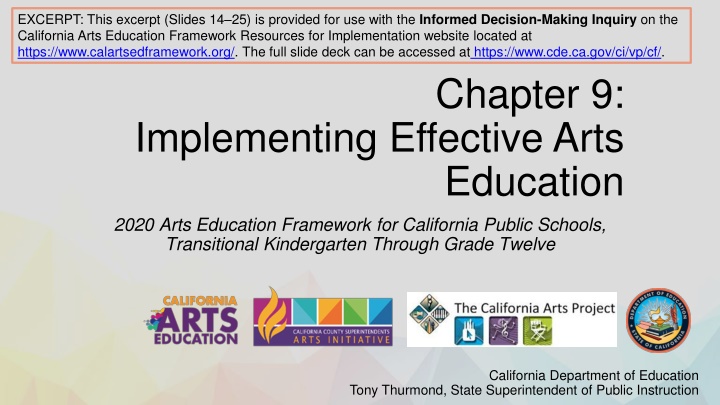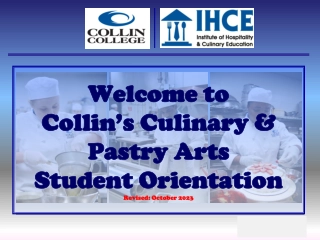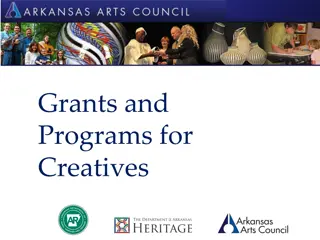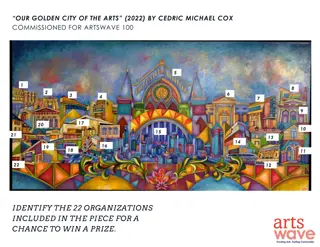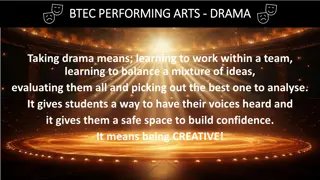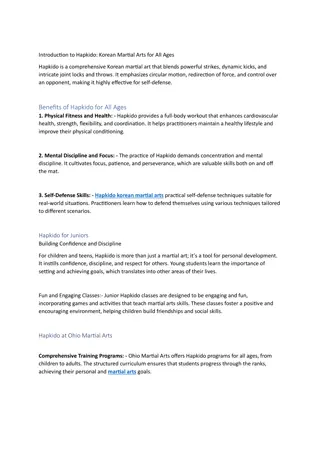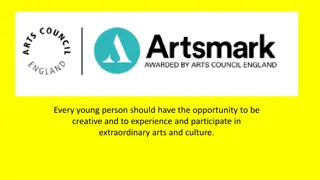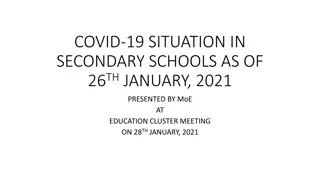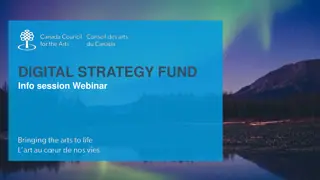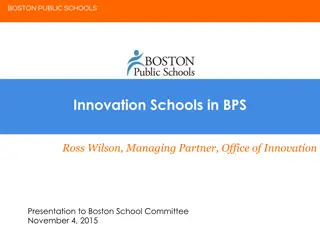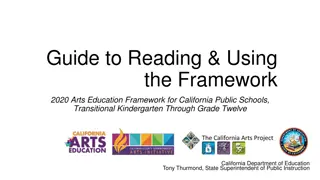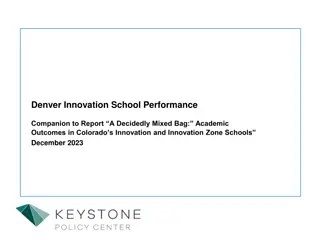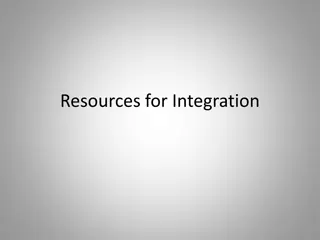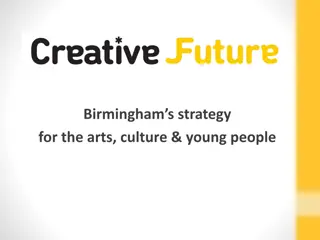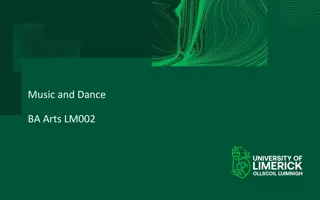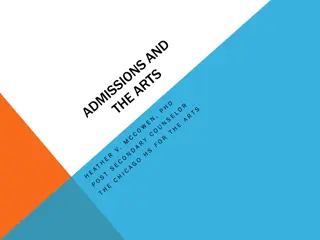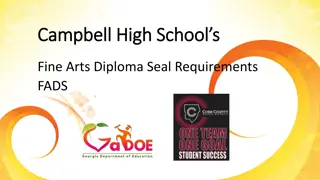Enhancing Arts Education Implementation in California Schools
Explore the fundamental components of arts education from the 2020 Arts Education Framework for California Public Schools. Learn about the importance of standards-based curriculum, scheduling considerations for both elementary and secondary students, and how curriculum guides arts instruction, providing essential resources for student development. Find insights on articulating learning expectations, accommodating diverse student needs, and ensuring access to advanced arts courses for holistic learning experiences.
Download Presentation

Please find below an Image/Link to download the presentation.
The content on the website is provided AS IS for your information and personal use only. It may not be sold, licensed, or shared on other websites without obtaining consent from the author.If you encounter any issues during the download, it is possible that the publisher has removed the file from their server.
You are allowed to download the files provided on this website for personal or commercial use, subject to the condition that they are used lawfully. All files are the property of their respective owners.
The content on the website is provided AS IS for your information and personal use only. It may not be sold, licensed, or shared on other websites without obtaining consent from the author.
E N D
Presentation Transcript
EXCERPT: This excerpt (Slides 1425) is provided for use with the Informed Decision-Making Inquiry on the California Arts Education Framework Resources for Implementation website located at https://www.calartsedframework.org/. The full slide deck can be accessed at https://www.cde.ca.gov/ci/vp/cf/. Chapter 9: Implementing Effective Arts Education 2020 Arts Education Framework for California Public Schools, Transitional Kindergarten Through Grade Twelve California Department of Education Tony Thurmond, State Superintendent of Public Instruction
Fundamental Components of Arts Education
STANDARDS-BASED CURRICULUM Guides Arts Instruction Curriculum, or course of study, is the content and plan for instruction. It is made up of the instructional resources, methods, and assessments needed to help students develop critical skills and knowledge. Along with high-quality and effective instruction, curriculum is an essential element that enables students to learn and thrive. See CDE Curriculum web page at https://www.cde.ca.gov/qs/ci/
STANDARDS-BASED CURRICULUM Articulates the Sequence of Instruction and Learning Expectations. It provides general guidance on diverse student learning needs and suggestions for accommodations and modifications; attends to the range of novice through advanced learners; provides a basis for formative and summative classroom assessment; and is grounded in the appropriate disciplinary pedagogies and methodologies.
SCHEDULING Considerations for Elementary Discrete instruction in each arts discipline builds foundational arts literacy, language, knowledge, and skills. Careful scheduling and planning of services ensures students are not missing arts learning time. Single-subject teachers may be assigned to work in multiple schools.
SCHEDULING Considerations for Secondary Middle School Students have access courses in all arts disciplines to continue to deepen learning in one arts discipline or possibly continue study in multiple arts disciplines. High School Students have access to opportunities to take yearlong courses in one or more arts disciplines and advanced courses in each year. Counselors and teachers are knowledgeable about requirements needed for postsecondary education and/or careers in the arts. Master scheduling should provide access to advanced course of study in the arts every year.
STAFFING Teachers Assigned to More than One School To support teachers, administrators can ensure adequate and protected time to teach beyond one short block of time; dedicated classrooms designed for safe learning in the arts; a secure place for storage and sufficient supplies, equipment, and resources for each student to use for arts learning; access to appropriate and needed technologies for teaching and for student learning and creating; and time to collaborate and build relationships with school site administration, staff, and parents.
STAFFING Administrators and Other Personnel Administrators and other personnel include district superintendents, arts coordinators, resource teachers, counselors, and support staff who are informed and knowledgeable about arts education to provide necessary and effective administrative and fiscal support; provide leadership and professional support to arts educators; advocate for high-quality arts education and understand the structure, differing needs, and nature of authentic learning in each arts discipline; and administrators are attentive to student-to-teacher ratios in arts classes in order to provide a safe learning environment for students to achieve the standards.
STAFFING Qualified Teachers Arts educators include multiple subject, single subject, and career technical education teachers who are recognized and respected as part of the school community and equal contributors to students well-rounded education; supported like teachers of other content areas, with resources and materials necessary to teach the arts, and with ongoing professional learning; and included and invited to contribute as equal members in district and school efforts, initiatives, and decisions.
FACILITIES Spaces for Arts Instruction Authentic learning in the arts requires dedicated, appropriate spaces for instruction that provide safe environments for students to learn; create; revise; and produce, perform, or present their work. This means Facilities built and maintained to provide teaching, learning, and performing environments that are physically safe Spaces that enable a creative, inclusive environment offer a foundation for students to authentically learn and safely thrive in the arts *While not all schools can provide studio-like spaces, with a few strategic modifications, classrooms can be effective arts teaching environments.
FACILITIES Attributes That Support Arts Learning Space for safe individual, small, and large group movement (theatre and dance) Space to accommodate individual, small group, and collaborative art making and presentation (visual arts, media arts, technical theatre) Access to water, proper ventilation, space for safe use of tools, and cleaning and storage areas (visual arts). Room for individual, ensemble, and whole group practice and rehearsal while protecting the hearing of teachers and students (music) Lighting, sound, climate control, and security for classrooms and performance/presentation venues (all) Suitable space, power, and appropriate internet connections for multiple computers and other electronic equipment (all)
SAFETY Teachers and students Should know, understand, and adhere to safety guidelines and codes in classrooms and performance venues Should follow safety guidelines in art making practices to protect themselves and others Are trained for safe use and handling of tools, facilities, artistic supplies, equipment, and materials Can access appropriate and well-maintained safety apparel and equipment Know the location of safety kits and fire extinguishers in classrooms and creative-making spaces and are trained in their use Follow fire, stage, and shop safety protocol outlines in guidelines from the Occupational Safety and Health Administration
ARTS MATERIALS AND EQUIPMENT Technology Students have access to and choices of technologies to engage in emerging and contemporary art practices, explore multiple approaches to developing portfolios, engage in collaboration and access to additional instructional supports as needed. Funding District and school budgets support equal access to necessary arts education-related expenditures and instructional materials, and provide for ongoing maintenance of tools, equipment, and technology. Safety Students have access to safe and healthy arts materials and equipment. California Guidance Instructional materials follow Education Code sections 60040 60045 and 60048 as well as the State Board of Education guidelines in Standards for Evaluating Instructional Materials for Social Content, 2013 Edition and Chapter 10: Instructional Materials of the framework.
